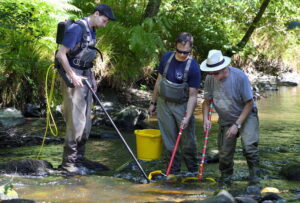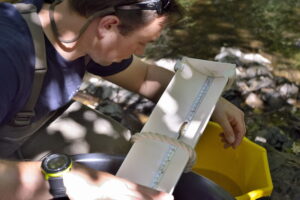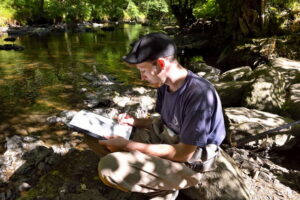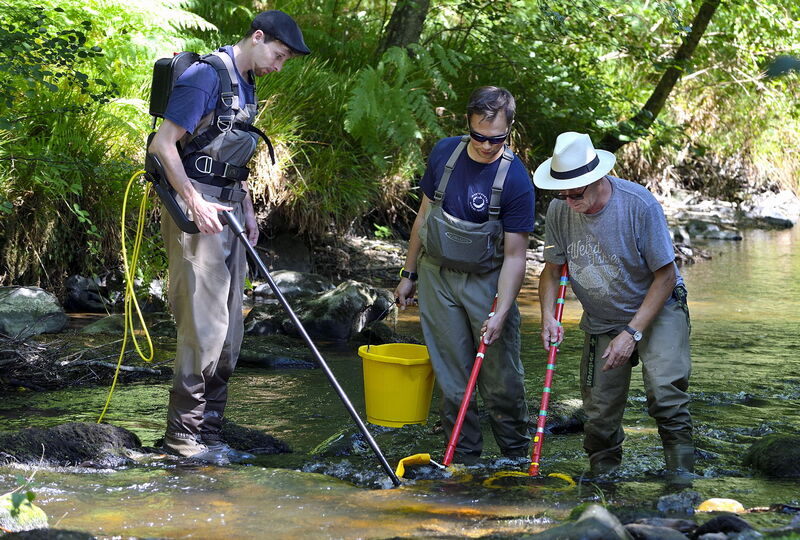OUR fisheries team members Sam Baycock and George Stone have been joined this year on the River Teign by Mike Rego for The Moorlander to share how our electrofishing surveys as part of the River Teign Restoration Project help monitor salmon stocks.
By Mike Rego
August has seen the start of a vital annual part of the River Teign Restoration Project, with the monitoring of salmon stocks as a general indication of the health of the River Teign and its tributaries.
Each year about 40 sites in the entire Teign catchment area are surveyed, which includes major tributaries such as the River Bovey and minor tributaries, and electrofishing surveys are carried out as a repeat of previous year’s surveys. The strategy is to monitor changes principally in the salmon but also the trout population, and thereby their breeding success as an overall indication of the health of the entire Teign river system.

Sam Baycock (centre) and George Stone (left) of Westcountry Rivers Trust and Neil Yeandle, Secretary of the Teign Angling and Conservation Association, conducting an electrofishing survey in the River Teign.
Credit: Mike Rego
The Teign Angling and Conservation Association (TACA) is the lead partner in the River Teign Restoration Project (RTRP), with other partners being Westcountry Rivers Trust, the National Trust, the Environment Agency, MED Theatre and locally-based internationally renowned artist, Peter Randall-Page RA.
Neil Yeandle, Secretary of (TACA), explains that the RTRP is a four-year project made possible by a grant of £243,100 awarded by The National Lottery Heritage fund. TACA have been conducting annual surveys since 2012, and have increased the number of sites surveyed annually from 20 to 40 since gaining Lottery funding in February 2021, which also enabled the recruitment of two part-time Project Officers to the project.
One of the aims of the RTRP is to establish a volunteer workforce ‘to help improve the habitat for migratory fish, raise awareness of the river’s importance for wildlife, and the key pressures causing fish declines’.
It is important to stress that despite the name, electrofishing when done correctly causes absolutely no harm to the fish. The Moorlander was invited by Neil Yeandle of TACA to come and observe one such routine survey in the River Teign, below Fingle Bridge in the Teign Gorge in early August.
The survey was conducted by Sam Baycock and George Stone of Westcountry Rivers Trust, assisted by Neil Yeandle. Sam Baycock explained that the E-Fish electrofishing equipment is carried in a backpack, powered by a 24v DC ‘Sealed Lead Acid’ battery, with the voltage in the water determined by the local water temperature and conductivity at each location, and the species of fish required to be collected based on the frequency.
A cathode is trailed in the water, and the anode is a circular hoop on a rod that can be directed at specific areas beneath the water surface. One the current is applied to the anode, the fish within a short distance are lured in. The current causes forced swimming – harmless involuntary muscular convulsion – and the fish are simply scooped up in a net and gathered in a large bucket. By the time the net is out of the water the fish are already alert and lively.

Sam Baycock of Westcountry Rivers Trust checking and measuring a Salmon Fry, probably about 8 months in age.
Credit: Mike Rego
The survey is carried out by electrofishing for a cumulative 5-minute period at each site, catching and measuring the length of Salmon and Trout Fry and Parr that are present, and then quickly releasing the fish back into the river unharmed in any way.
The water temperature is critical – electrofishing surveys cannot be conducted at water temperatures of greater than 18°C, as due to lower levels of oxygen in the water the fish can easily become distressed. Despite the current heatwave at the time of the survey, the water temperature at the time of the survey was measured at 16°C.
Once electrofishing has been carried out for a total of 5 minutes the collected fish are taken to the riverside, air pumps are inserted into the bucket and their length is measured and tabulated individually by hand before they are transferred to another aerated bucket for release back into the river as quickly as possible in order to avoid causing any stress.
Neil Yeandle of TACA explained that by tabulating all the data, the results can be monitored over the years for changes in trends – if a site changes for the worse, investigations can be carried out to identify the causes, and thereby a possible action plan to restore the health of the local river environment. Such problems may indicate pollution from sewage perhaps, or significant tree growth or debris blocking the river.

George Stone of Westcountry Rivers Trust tabulating the length of Salmon and Brown Trout Fry and Parr caught during a five minute period of electrofishing, for measuring the comparative health of the river and the local fish population against previous year’s surveys at the same specific locations.
Credit: Mike Rego
The result of the 5 minutes of surveying that The Moorlander observed at the survey location was 75 Salmon Fry, 10 Salmon Parr, five Trout Parr, as well as 12 missed Fry and two missed Parr that could have been either Salmon or Trout, but as George and Sam were quick to point out, it was an excellent result making the location ‘a Grade A site’.
Neil Yeandle commented that since TACA began surveying in 2012, he has seen an overall slight reduction in Salmon numbers, however he felt that the River Teign “is doing relatively well compared to other rivers in the southwest”. He also observed that some results this year so far have been encouraging, “with exceptionally good results at particular locations”.
The following weblinks can provide more information about the River Teign Restoration Project and associated organisations mentioned in this article:
https://www.riverteignrestorationproject.co.uk/
https://upper-teign-fishing.org.uk
http://lowerteignfishing.co.uk/index.html
https://www.efish-solutions.com/
https://www.gov.uk/government/organisations/environment-agency
https://www.nationaltrust.org.uk/
https://www.peterrandall-page.com/
ENDS

